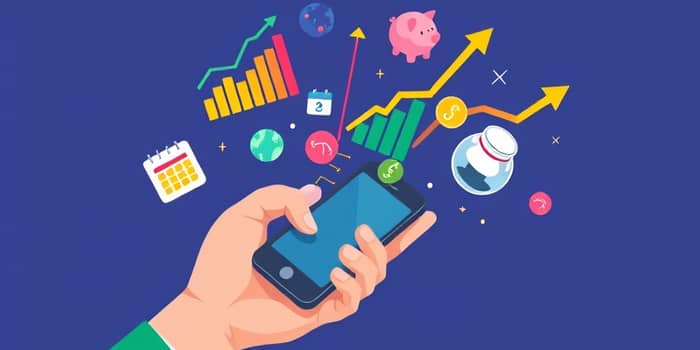Your path to financial freedom begins with clear targets and the right tools. Financial goal-setting apps are revolutionizing how individuals manage money, from everyday budgeting to long-term investing. By combining intuitive design with powerful analytics, these apps offer users real-time progress visualization features and actionable insights to stay on track.
In this comprehensive guide, we explore the importance of tracking your finances, highlight top app categories, dive deep into leading solutions, and show you how to apply the SMART methodology to achieve lasting success.
Why Financial Goal-Setting Matters
When it comes to money management, clarity breeds confidence. A 2021 study revealed that users who set and monitor financial objectives are twice as likely to reach their targets compared to those who don’t track spending or savings[3][6]. This dramatic difference stems from accountability, frequent checkpoints, and visual feedback loops.
Beyond motivation, these apps foster disciplined habits. Users receive timely reminders, see spending patterns, and adjust goals dynamically. This iterative process turns abstract ambitions—like saving for a home—into concrete milestones that are consistently achievable.
Top Categories of Goal-Setting Apps
Financial apps fall into four core categories, each tailored to distinct needs: budgeting, comprehensive life management, investment guidance, and productivity-driven goal trackers. Understanding these classifications helps you choose the right tool for your personal financial journey.
This breakdown provides a snapshot of features, pricing, and focus areas, helping you evaluate which app aligns with your objectives.
Deep Dive into Leading Apps
- Mint: Best for budgeting beginners with millions of active users and comprehensive expense tracking dashboards.
- PocketGuard: Connects to accounts, manages debt, and highlights your disposable income in daily snapshots.
- Life Planner: Combines financial management with habit tracking and mood journals to create a holistic personal finance experience.
- Fidelity Spire: Offers goal-based planning and projections, ideal for retirement and major milestones.
- Betterment: Automated portfolios, personalized risk assessment, and external account syncing for total wealth management.
- ClickUp: Project management meets finance, with task automation, real-time analytics, and custom goal templates.
Mint stands out for its intuitive design, free access, and credit score monitoring, boasting over 10 million downloads across Android and iOS[4][6]. In contrast, PocketGuard excels at simplifying complex financial data into easy-to-understand summaries, making debt reduction feel achievable.
Life Planner uniquely bridges personal productivity with budgeting, allowing users to journal, track moods, and set financial benchmarks—all within one platform[3]. Fidelity Spire and Betterment cater to investors, offering automated portfolio management and risk assessment that align your money with life goals.
ClickUp, originally a productivity powerhouse, has integrated financial goal-tracking features that slap your objectives into view, as one user raves: “ClickUp will literally slap your goals to your face… It forces me to prioritize and build habits.”[1]
User Experience and Key Features
Ease of use and visual feedback drive adoption. Most apps integrate securely with bank and investment accounts, providing up-to-date balances and transactions. Customizable alerts and rules—such as automatic transfers when you exceed spending limits—encourage positive behaviors and eliminate guesswork.
Progress charts, calendar views, and leaderboard-style achievements turn financial management into a rewarding journey. These tools leverage human psychology, using small wins to maintain momentum.
- Seamless bank and investment integration
- Customizable spending plans and templates
- Interactive progress charts and dashboards
- Automated reminders and habit trackers
Pricing and Value Comparison
While many goal-setting apps offer a free tier, advanced features typically require a subscription. Mint remains free, monetizing through advisory services. PocketGuard offers premium debt-management tools under a paid plan. Life Planner, Betterment, and Fidelity Spire use tiered subscriptions based on feature sets.
ClickUp’s pricing scales from free basic plans to enterprise-level customization. At $7 to $12 per user monthly, it appeals to teams and individuals seeking extensive analytics and automation. Consider your frequency of use and the specific tools you need to determine the best fit.
Applying SMART Methodology to Financial Goals
The SMART framework—Specific, Measurable, Achievable, Relevant, Time-bound—provides a structured approach to goal creation. Modern apps incorporate these principles by prompting users to add deadlines, set benchmarks, and adjust targets based on historical performance[7].
By breaking down complex ambitions into smaller tasks, you foster a sense of progress. Example: Instead of “save money,” set a goal to “save $500 per month for six months.” This clarity fuels consistency.
- Specific: Define precise monetary targets
- Measurable: Use numeric trackers and charts
- Achievable: Base goals on income and expenses
- Relevant: Align with personal values and life plans
- Time-bound: Attach realistic deadlines
Future Trends in Financial Goal-Setting Technology
Looking ahead, artificial intelligence and machine learning will personalize financial advice even further. Predictive analytics may recommend saving adjustments based on lifestyle changes, while gamification elements—like community challenges—will enhance engagement.
Integration with wearable devices and voice assistants promises on-the-go updates. Imagine receiving a daily brief on your savings progress while making morning coffee or adjusting budgets via voice command.
Conclusion
Financial goal-setting apps empower users to take control of their money through structured planning, visual feedback, and behavioral nudges. By choosing an app that aligns with your needs—whether you’re budgeting daily expenses, managing investments, or fostering healthy financial habits—you unlock a roadmap to achieve your dreams.
Embrace the power of technology and start setting SMART financial goals today. With the right tools and a clear vision, you can transform your financial future one milestone at a time.
References
- https://getmarlee.com/blog/goal-tracking-app
- https://www.purdueglobal.edu/blog/student-life/budgeting-apps-personal-finance-tools/
- https://thelifeplanner.co/blog/post/the_best_budgeting_apps_for_2025.html
- https://www.dividend.com/how-to-retire/5-budgeting-apps-to-help-you-hit-your-financial-goals/
- https://prateeksha.com/blog/top-10-wealth-management-apps-to-optimize-your-finances-in-2025
- https://www.netguru.com/blog/top-wealth-management-apps
- https://asana.com/resources/smart-goals
- https://clickup.com/blog/goal-tracking-apps/










